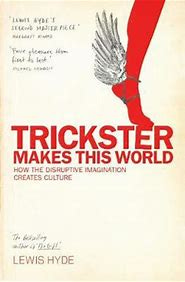(This Book) is full of “Saturn dreaming of Mercury.” It is, among other things, a description and invocation of the kind of imagination that stirs to life at the beginning of a journey. It is about trickster figures—Coyote, Hermes, Mercury, and more—and all tricksters are “on the road.” They are the lords of in-between. A trickster does not live near the hearth; he does not live in the halls of justice, the soldier’s tent, the shaman’s hut, the monastery. He passes through each of these when there is a moment of silence, and he enlivens each with mischief, but he is not their guiding spirit. He is the spirit of the doorway leading out, and of the crossroad at the edge of town (the one where a little market springs up). He is the spirit of the road at dusk, the one that runs from one town to another and belongs to neither. There are strangers on that road, and thieves, and in the underbrush a sly beast whose stomach has not heard about your letters of safe passage. Travelers used to mark such roads with cairns, each adding a stone to the pile in passing. The name Hermes once meant “he of the stone heap,” which tells us that the cairn is more than a trail marker—it is an altar to the forces that govern these spaces of heightened uncertainty, and to the intelligence needed to negotiate them. Hitchhikers who make it safely home have somewhere paid homage to Hermes.
The road that trickster travels is a spirit road as well as a road in fact. He is the adept who can move between heaven and earth, and between the living and the dead. As such, he is sometimes the messenger of the gods and sometimes the guide of souls, carrying the dead into the underworld or opening the tomb to release them when they must walk among us. Sometimes it happens that the road between heaven and earth is not open, whereupon trickster travels not as a messenger but as a thief, the one who steals from the gods the good things that humans need if they are to survive in this world. Tricky Prometheus stealing fire is the famous Western example, but the motif of freeing some needed good from heaven is found all over the world. Along the North Pacific coast, for example, the trickster Raven is a thief of water and daylight; on the island of Japan, it was a trickster who released the arts of agriculture from their heavenly enclosure. (It is at well-guarded barriers that these figures are especially tricksters, for here they must be masters of deceit if they are to proceed.)
In short, trickster is a boundary-crosser. Every group has its edge, its sense of in and out, and trickster is always there, at the gates of the city and the gates of life, making sure there is commerce. He also attends the internal boundaries by which groups articulate their social life. We constantly distinguish—right and wrong, sacred and profane, clean and dirty, male and female, young and old, living and dead—and in every case trickster will cross the line and confuse the distinction. Trickster is the creative idiot, therefore, the wise fool, the gray-haired baby, the cross-dresser, the speaker of sacred profanities. Where someone’s sense of honorable behavior has left him unable to act, trickster will appear to suggest an amoral action, something right/wrong that will get life going again. Trickster is the mythic embodiment of ambiguity and ambivalence, doubleness and duplicity, contradiction and paradox.
…….



